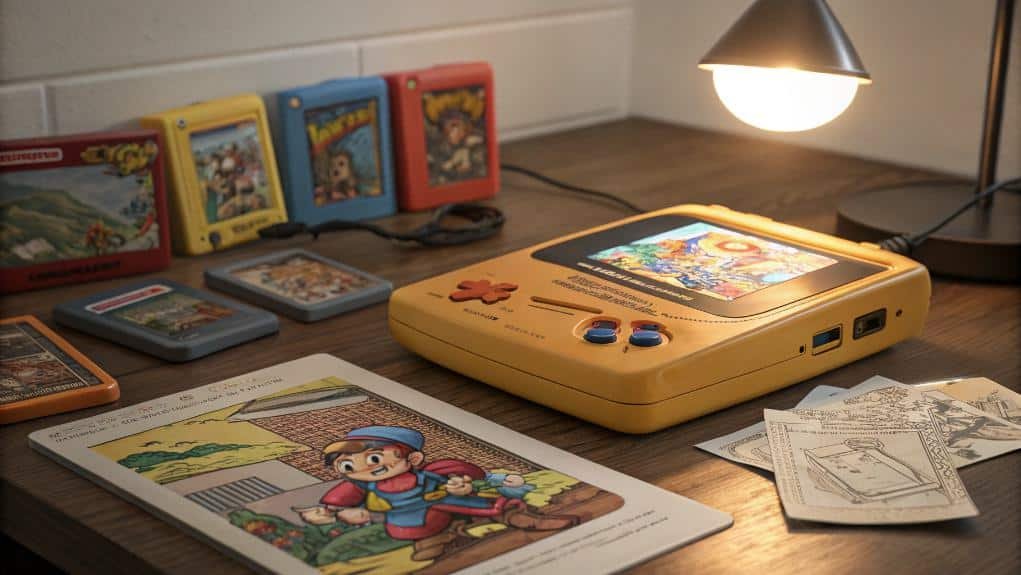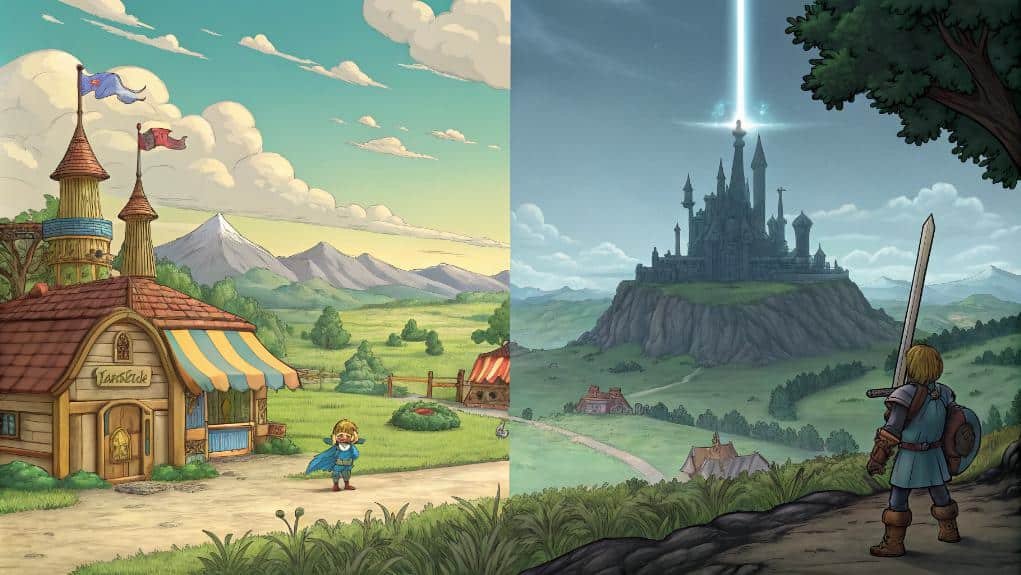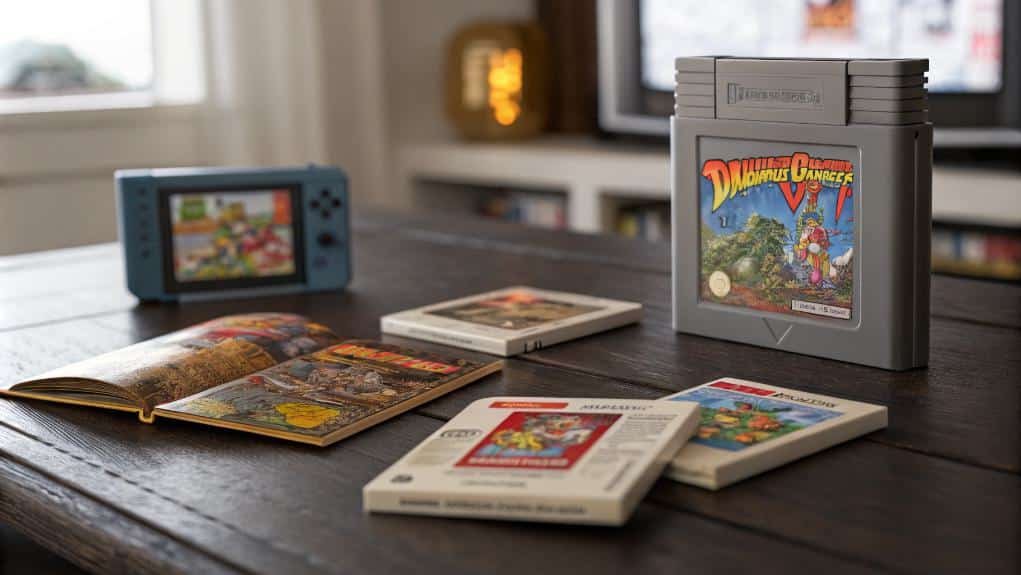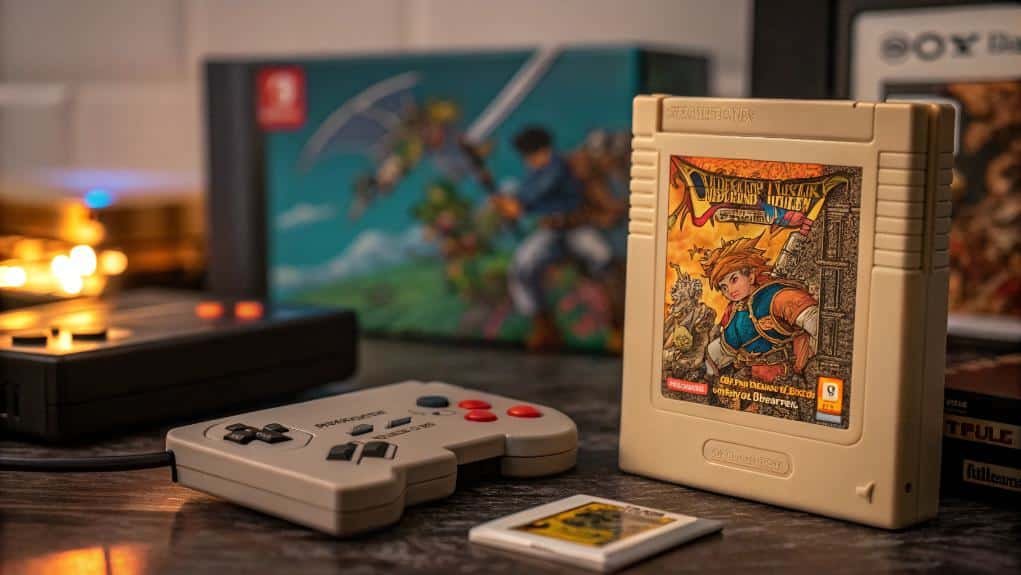The history of Dragon Quest VI showcases a significant evolution in RPG design, marked by its ambitious development challenges. Initially, the team aimed to resurrect the job system from Dragon Quest III while introducing a dual-world concept. Development stretched from one to two and a half years, facing obstacles like AI optimization and memory constraints. The game's turn-based mechanics and nuanced character progression received acclaim, yet criticisms emerged regarding its narrative depth compared to its predecessor. With over 3.2 million copies sold, it solidified its legacy in the genre, influencing many future RPGs. There's much more to uncover about its impact.
Key Takeaways
- Dragon Quest VI was developed over two and a half years, initially extending from a one-year timeline due to design challenges.
- The game features a dual world setup, contrasting the dream-like Lower World with the reality-based Upper World.
- It introduced a revived job system from Dragon Quest III, allowing for character class evolution and strategic gameplay.
- The game received critical acclaim, with a Famitsu score of 34/40 and sales exceeding 3.2 million copies in Japan for the SNES version.
- Dragon Quest VI influenced later RPGs with its battle mechanics and character-driven episodic storytelling, solidifying its legacy in the genre.
Development History

The development history of Dragon Quest VI reveals a complex journey marked by ambitious goals and significant challenges. After the completion of Dragon Quest V, the team held their first meeting in October to brainstorm new ideas. Their vision included reviving the job system from Dragon Quest III and implementing a dual world setup.
However, initial plans for a one-year development cycle stretched to two and a half years, largely due to design challenges and team dynamics. The team faced several obstacles, such as optimizing AI that initially took six seconds to calculate actions. Enhanced utilization of SFC hardware allowed for significant improvements in graphics and sound, further motivating the team to overcome their challenges.
Memory constraints also loomed large; the project had to expand from 24Mbit to 32Mbit to accommodate the vast amount of data, which included around 5000 pages of scenario planning and extensive notes filling 20 thick binders.
Despite these setbacks, the team tackled memory management issues and made tough decisions, cutting some events to guarantee the game's completion. As a result, the collaborative effort of Yuji Horii, Manabu Yamana, and Koichi Sugiyama ultimately produced a game that balanced complexity with the technical limitations they faced.
Game Structure and Mechanics
Dragon Quest VI presents a rich tapestry of gameplay mechanics that enhance the player experience while retaining the series' classic charm. At its core, the game employs turn-based battles with a first-person perspective, allowing players to engage in exhilarating combat against a variety of animated monsters.
The class system stands out, featuring basic classes like Warrior and Mage, which evolve into hybrid and special classes through mastery, enriching the strategic depth of character progression. Players must carefully consider class evolution to optimize their combat strategy, revealing unique abilities and stat bonuses that directly impact battle performance.
The game encourages exploration with its overhead perspective, allowing players to discover hidden items and engage in mini-games like the Slime Arena. The AI improvements guarantee that party members make informed decisions based on enemy resistances, enhancing overall combat effectiveness. Additionally, the new mini-games introduced in the DS version, such as the Best Dresser Contest, provide players with fresh challenges that diversify the gameplay experience.
Furthermore, the introduction of a wagon system facilitates character swapping, adding flexibility to party composition. With a day and night cycle influencing events, Dragon Quest VI combines traditional mechanics with innovative features, offering a compelling experience that keeps players engaged from beginning to end.
Plot and Storyline

Set against the backdrop of two interwoven domains, Dragon Quest VI's plot intricately explores the themes of dreams and reality. The game features dual worlds: the Lower World and the Upper World, each with its own mysteries and character arcs. Players begin with a vivid dream sequence where the hero faces the demon king Murdaw, only to awaken and find this battle was merely a prelude. This initial dream sets the stage for the hero's journey through both domains, where villain motivations and identity themes emerge as central elements. The storyline includes various character interactions that enhance character development throughout the game.
The story unfolds episodically, allowing players to engage with various characters like Carver, Milly, and Ashlynn, each representing unique struggles and growth. As the hero navigates these dual worlds, the influence of the demon lord pulls the strings, merging dreams with reality. The following table summarizes key aspects of the plot:
| Element | Description | Significance |
|---|---|---|
| Dual Worlds | Lower and Upper Worlds | Exploration of identity |
| Dream Sequences | Initial battle with Murdaw | Sets the tone for adventures |
| Character Arcs | Growth of Carver, Milly, Ashlynn | Deepens emotional investment |
| Villain Motivations | Demon lord's influence | Drives narrative tension |
| Episodic Storytelling | Smaller stories within the main plot | Enhances engagement
Reception and Legacy
Upon its release, *Dragon Quest VI* garnered critical acclaim, earning impressive scores from major gaming publications, including a notable 34/40 from Famitsu for both its SNES and DS versions. The game achieved remarkable sales figures, with over 3.2 million copies sold in Japan for the SNES, making it the best-selling game of 1995. The DS version continued this trend, selling over 1.2 million copies by March 2010.
While praised for its well-balanced battle mechanics and engaging gameplay, *Dragon Quest VI* faced scrutiny in narrative depth compared to its predecessor, *Dragon Quest V*. Critics noted that the game introduced innovative features, such as animated monster attacks and a refined Vocation system, yet these elements didn't fully elevate the overall experience. Additionally, many players found the early game pacing to be a significant hurdle to overcome before the game truly shines.
Despite its flaws, including a slow start and underdeveloped characters, the game remains a solid JRPG that retains enjoyable elements of the series.
Its unique real-world and dream-world setting may have influenced later RPGs like *Chrono Cross* and *Final Fantasy X*, solidifying its legacy as a classic, albeit often ranked lower in the Zenithian trilogy.
Technical Details

The technical advancements in *Dragon Quest VI* considerably contributed to its gameplay experience, setting it apart from its predecessors. One of the most notable graphics improvements was the introduction of fully animated monsters in battle, each boasting up to three frames per action. This animation brought a newfound dynamism to combat, enhancing visual appeal and engagement.
The game maintained its turn-based combat structure while refining battle mechanics. It shifted from purely random encounters to a more strategic step-based system, allowing players to anticipate challenges more effectively. Additionally, the character class system let players master specific classes, acquiring new skills and spells through combat, which added layers of strategy to character development. The job system from *Dragon Quest III* also returned, further deepening the customization options available to players.
Navigation also saw enhancements, with quick walking speeds and automatic door openings streamlining exploration in towns and dungeons. The world map became more interactive, revealing grayed-out sections upon exploration and allowing easy access with the R button.
In-battle descriptions provided clarity on spells and skills, improving player understanding and strategy. Overall, these technical details not only enhanced *Dragon Quest VI*'s gameplay but also established it as a milestone in RPG design.

